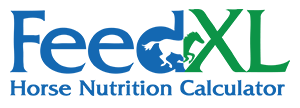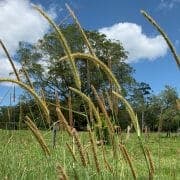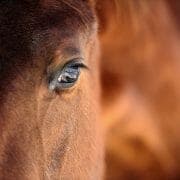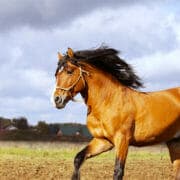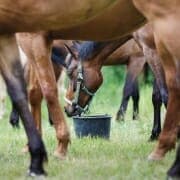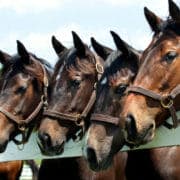Feeding Sick or Injured Horses
Sick or injured horses, including horses suffering from burns, have different requirements to normal healthy horses, both in the types of nutrients they need and the sorts of feeds they can be fed. To determine the best thing to feed sick horse (or an injured horse) the following guidelines should be followed:
1. Don’t make any drastic changes to the diet
Sudden changes to any horse’s diet should be avoided and this is never more the case than when you have a sick or injured horse on hand. If your horse was on a primarily forage diet (mainly pasture, hay or chaff) prior to the sickness or injury, you should attempt to maintain the horse on a largely forage diet. Likewise, if your horse was being hard fed, you can continue to hard feed the horse, but don’t suddenly introduce hard feeds to a horse that wasn’t on them previously, and unless there is a good medical reason (for example in the case of laminitis) you should not just suddenly stop feeding hard feeds or quickly switch to a new feed.
Keeping their feed consistent will keep them happier (they are creatures of habit and don’t like sudden changes) and also make sure you avoid problems like colic that can be associated with sudden changes in feed.
It is quite likely that you are going to need to make some changes to a horse’s diet. If this is the case, do it as slowly as possible or practical.
Tip:
If your horse has to go to a veterinary hospital, take along your horse’s feed he or she is used to having and leave clear directions on what and how much your horse is normally fed. If your horse was not hard fed before going to the clinic leave a note with the staff and if you have to, stick a note on your horse’s stable door requesting your horse is not fed any hard feed, as most horses in vet clinics will get some sort of hard feed unless otherwise directed.
2. Introduce new feeds as gradually as possible
There are going to be cases when your horse:
- No longer has access to the feed he or she was used to (as in the case of fires burning out pastures);
- Needs new feeds or supplements to make sure requirements for the healing process are met; or
- Cannot physically eat their normal diet due to injuries to the muzzle or mouth
When a horse no longer has access to their normal feed, you should find something as similar as possible to replace it with. For example, if a horse’s normal grass pasture is burnt out by fire, you should initially put the horse on a diet of free choice grass hay. Don’t change them to something like lucerne/alfalfa hay or a hard feed-based diet straight away as it is just too different from what they were used to and may cause problems like diarrhoea and colic.
When additional feeds or supplements need to be added you should do so as slowly as possible.
If the horse can’t eat its normal diet due to an injured mouth or muzzle, you should find ‘easy to eat’ versions of feeds similar to the feeds your horse was used to. So for example, if your horse was on grass pasture or grass hay, use oaten or wheaten chaff as an easy-to-eat alternative. If your horse was eating lucerne hay, use lucerne chaff. And if your horse is finding its hard feed difficult to chew and swallow, soak it in warm water to make it soft before feeding.
Tip:
If your horse changes from moist pasture to hay suddenly keep a very close eye on water intake and use water sweetened with molasses or apple juice to encourage drinking if water intake is low. Not drinking enough when eating dry hay puts horses at real risk of impaction colic.
3. Feed enough feed, but not too much
A sick or injured horse needs to have its calorie intake carefully managed. There are two main situations you need to be aware of:
- A horse with an injury that is confined to box rest – in these situations you need to ensure the horse does not become overweight through inactivity and overfeeding. Being overweight will put more stress on an injury, particularly if it is some sort of leg or skeletal injury or surgery. In addition, overfeeding will make the horse more agitated or hyperactive while confined and may lead to the horse injuring itself again while locked up. The best diet for these horses is free choice moderate to good quality grass hay, a low dose rate vitamin and mineral supplement, salt lick and water. Providing access to free choice hay will also help relieve boredom. It is a good idea to feed the hay through a slow-feeding hay net or put it in two or three normal hay nets to slow intake and prolong the amount of time the horse is eating in a 24-hour period. A horse that eats for a large part of its day will be much happier and settled than a horse that finishes its feed within a couple of hours. For more help with this, click here to read our blog post ‘How to feed a horse confined to a stable’.
- A horse with a sickness or severe injury (including burns) – in these situations the most important considerations are to get the horse to eat (as going off feed can be a major problem) and stop them from losing weight. A sick or severely injured horse that is losing weight will not be able to properly start the healing process because its body is in a state of breakdown and not rebuild. If a horse doesn’t eat, it is also likely that its immune system will be compromised, again slowing the healing process and exposing your horse to the risk of secondary disease and infection. First and foremost, with these horses you must get them to eat (see below for tips on getting a horse to eat). Once they are eating, they need to be fed a diet with adequate calories and protein to allow them to maintain their bodyweight or gain bodyweight where required. Feeds such as lucerne hay, grass hay and good quality sweetfeeds or pellets/cubes may be needed for the horse to maintain weight. These horses need to be condition scored regularly and their rations adjusted according to whether they are losing, maintaining or gaining weight.
Tips for getting a horse to eat
- Make sure you are managing pain as pain is one of the first things that will put them off their feed. Work with your vet to develop a good pain management strategy.
- Don’t put medications in your horse’s feed – most medications are not particularly tasty so instead of putting them in the feed wait until after your horse has eaten and give it to them via a paste made with apple sauce.
- Beware of ulcers. Horses that are stressed and off their feed are at real risk and this will further reduce their appetite.
- If your horse won’t eat its normal feed, you can try adding some things including:
- Bran
- Honey
- Molasses
- Applesauce
- Grated carrot or apple
- Brewer’s yeast; or
- Lucerne chaff
- Be careful adding salt. If you make a feed too salty your horse won’t eat it, so add it sparingly if at all and try feeds without any salt to see if it helps with their appetite.
- Make sure the feed bin is in a comfortable position for the horse to reach. For example if it has a painful foreleg injury, elevate the feed bin slightly to reduce the amount of pressure a horse has to put on its legs to eat.
- Allow your horse to graze when possible – horses that won’t eat will generally still graze, and periods of time grazing may be enough to stimulate their appetite so they will eat what you are trying to feed them.
- Feed in frequent small meals and remove uneaten feed every 2 hours to keep it fresh and palatable.
If none of these strategies work and the horse still will not eat, contact your veterinarian that is caring for the horse and discuss the options available for tube feeding if required.
4. Make sure the diet contains everything your horse needs
Never is feeding a balanced diet more important than when feeding a horse recovering from sickness or injury. Protein and certain vitamins and minerals are critically important for promoting the healing process as is ensuring the horse is receiving the correct amount of calories.
If your horse is only eating a small amount of feed each day, the diet should be balanced so that its nutrient needs are largely met within that small meal size. This may involve feeding high protein supplements, concentrated vitamin mineral supplements and using high energy oils and grains to help meet calorie requirements.
FeedXL allows you to balance diets accurately for horses recovering from illness or injury. Simply choose ‘Horse Recovering from Illness or Injury’ or ‘Growing Horse Recovering from Illness or Injury’ when entering your horse’s details.
Special Note for Burns Victims
Severe burns cause:
- Increased fat metabolism
- Protein breakdown in the body; and
- Increased use and excretion of vitamin C and B-vitamins
Thus, a severely burnt horse’s requirements for these nutrients as well as fluid and calories can be increased up to 100% above maintenance needs.
The diet for these horses should be:
- High in protein (14 – 16% of the total diet) – this makes alfalfa/lucerne a useful forage for these horses.
- High in fat (7 – 10% of total energy intake); and
- Fortified with vitamins and minerals including higher than normal levels of vitamin E and the B-group vitamins as well as vitamin C.
Finally…
If you are not sure where to start with feeding a sick or injured horse, seek professional help. We can certainly help on the FeedXL Members Facebook Group. Feeding a horse the wrong thing when sick or failing to recognise that your horse has special requirements can slow the healing process, suppress your horse’s immune system, and expose your horse to secondary disease and infections. It is important to get it right.
Not yet a Member of FeedXL?
Get EVEN MORE practical and personalised feeding guidance when you sign up to FEEDXL.
Do you have a question or comment? Do you need help with feeding?
We would love to welcome you to our FeedXL Horse Nutrition Facebook Group. Ask questions and have them answered by PhD and Masters qualified equine nutritionists and spend time with like-minded horse owners. It’s free!
Click here to join the FeedXL Horse Nutrition Facebook Group
